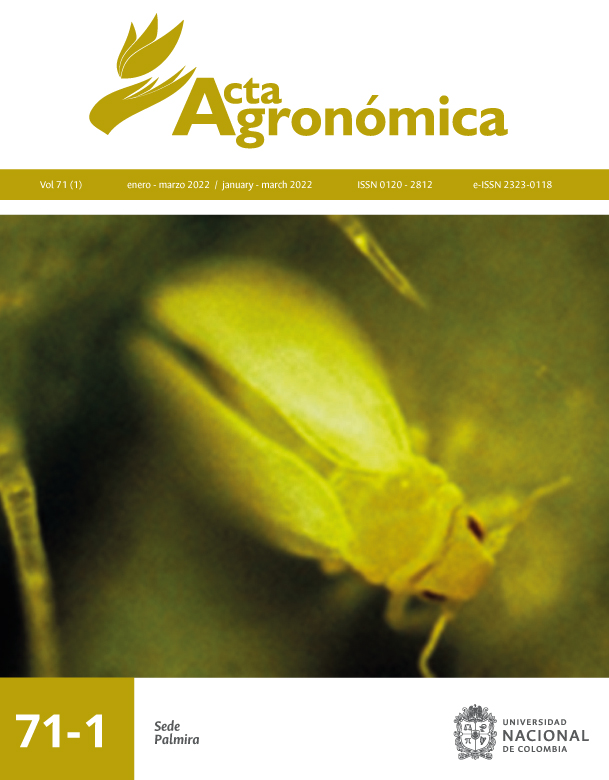Impacto del uso de suelo sobre el secuestro del carbono orgánico en un área natural de Medellín, Colombia
Impact of land use on organic carbon sequestration in a natural area of Medellín, Colombia
DOI:
https://doi.org/10.15446/acag.v71n1.101342Palabras clave:
cobertura vegetal, Materia orgánica del suelo., Propiedades del suelo, Significancia estadística (es)Plant cover, soil organic matter, soil properties, Statistical significance (en)
Descargas
Este estudio evaluó el secuestro de carbono orgánico del suelo (COS) en cuatro coberturas vegetales (vegetación secundaria [VS], plantaciones forestales de Eucalyptus globulus [EUC] y Pinus patula [PIN] y pasturas [PAS]) y su correlación con las propiedades fisicoquímicas del suelo. Se tomaron muestras de suelo a dos profundidades en el horizonte A (0-10 y 10-20 cm). Igualmente, se midieron variables fisicoquímicas del suelo para evaluar su relación con los cambios en el secuestro de COS. Encontramos el mayor almacenamiento de COS en el horizonte A de EUC (100.5 ton C ha−1), seguido por PAS (75.55 ton C ha−1), PIN (66.70 ton C ha−1) y VS (56.53 ton C ha−1). Más aún, el COS se correlacionó positiva y significativamente con la máxima capacidad de retención de agua, índice de estabilidad estructural, contenidos de arena, arcilla y carbono en ácidos húmicos y fúlvicos. Sin embargo, el COS se correlacionó negativamente con la densidad aparente, estado de agregación, contenidos de limo, pH y la CICE. Estos resultados sugieren que el cambio de cobertura afecta significativamente el secuestro de COS, las características de la materia orgánica del suelo y las propiedades fisicoquímicas del suelo.
This study evaluated soil organic carbon sequestration (SOC) in four vegetation covers (secondary vegetation [VS], forest plantations of Eucalyptus globulus (EUC) and Pinus patula [PIN] and pastures [PAS]), and its correlation with the physicochemical properties of the soil. Soil samples were taken at two depths in the A horizon (0-10 and 10-20 cm). Soil physicochemical variables were measured to evaluate their relationship with changes in SOC sequestration. We found that the highest SOC storage was in horizon A of EUC (100.5 ton C ha−1), followed by PAS (75.55 ton C ha−1), PIN (66.70 ton C ha−1) and SV (56.53 ton C ha−1). The SOC was significantly and positively correlated with the maximum water retention capacity, structural stability index, content of sand, clay, and carbon in humic and fulvic acids. However, SOC was negatively correlated with apparent density, state of aggregation, silt content, pH and CICE. These results suggest that cover change significantly affects SOC sequestration, soil organic matter characteristics, and soil physicochemical properties.
Referencias
Aide, T. M., Zimmerman, J. K., Pascarella, J. B., Rivera, L. y Marcano‐Vega, H. (2000). Forest regeneration in a chronosequence of tropical abandoned pastures: implications for restoration ecology. Restoration Ecology, 8(4), 328-338. https://doi.org/10.1046/j.1526-100x.2000.80048.x DOI: https://doi.org/10.1046/j.1526-100x.2000.80048.x
Al-Shammary, A. A. G., Kouzani, A. Z., Kaynak, A., Khoo, S. Y., Norton, M. y Gates, W. (2018). Soil bulk density estimation methods: A review. Pedosphere, 28(4), 581-596. https://doi.org/10.1016/S1002-0160(18)60034-7 DOI: https://doi.org/10.1016/S1002-0160(18)60034-7
Beillouin, D., Cardinael, R., Berre, D., Boyer, A., Corbeels, M., Fallot, A. y Demenois, J. (2022). A global overview of studies about land management, land‐use change, and climate change effects on soil organic carbon. Global change biology, 28(4), 1690-1702. https://doi.org/10.1111/gcb.15998 DOI: https://doi.org/10.1111/gcb.15998
Blake, G. R. y Steinhardt, G. C. (2016). Distribución del tamaño de partículas. En: Enciclopedia de la ciencia del suelo (pp. 505–510). Springer: Dordrecht, Países Bajos. https://doi.org/10.1007/978-1-4020-3995-9_407 DOI: https://doi.org/10.1007/978-1-4020-3995-9_407
Buyanovsky, G. A., Aslam, M. y Wagner, G. H. (1994). Carbon turnover in soil physical fractions. Soil Science Society of America Journal, 58(4), 1167-1173. https://doi.org/10.2136/sssaj1994.03615995005800040023x DOI: https://doi.org/10.2136/sssaj1994.03615995005800040023x
Dos Santos, U. J., Duda, G. P., Marques, M. C., Valente de Medeiros, E., de Sousa Lima, J. R., Soares de Souza, E. y Hammecker, C. (2019). Soil organic carbon fractions and humic substances are affected by land uses of Caatinga forest in Brazil. Arid Land Research and Management, 33(3), 255-273. https://doi.org/10.1080/15324982.2018.1555871 DOI: https://doi.org/10.1080/15324982.2018.1555871
Gao, L., Wang, B., Li, S., Wu, H., Wu, X., Liang, G. y Degré, A. (2019). Soil wet aggregate distribution and pore size distribution under different tillage systems after 16 years in the Loess Plateau of China. Catena, 173, 38-47. https://doi.org/10.1016/j.catena.2018.09.043 DOI: https://doi.org/10.1016/j.catena.2018.09.043
Guo, L. B. y Gifford, R. M. (2002). Soil carbon stocks and land use change: A meta-analysis. Global change biology, 8(4), 345-360. https://doi.org/10.1046/j.1354-1013.2002.00486.x DOI: https://doi.org/10.1046/j.1354-1013.2002.00486.x
Haynes, R. J. y Francis, G. S. (1993). Changes in microbial biomass C, soil carbohydrate composition and aggregate stability induced by growth of selected crop and forage species under field conditions. Journal of Soil Science, 44(4), 665-675. https://doi.org/10.1111/j.1365-2389.1993.tb02331.x DOI: https://doi.org/10.1111/j.1365-2389.1993.tb02331.x
Herrick, J. E., y Wander, M. M. (2018). Relationships between soil organic carbon and soil quality in cropped and rangeland soils: the importance of distribution, composition, and soil biological activity. En: Soil processes and the carbon cycle (pp. 405-425). Nueva York: CRC Press. Google Scholar DOI: https://doi.org/10.1201/9780203739273-28
Hutchinson, J. J., Campbell, C. A. y Desjardins, R. L. (2007). Some perspectives on carbon sequestration in agriculture. Agricultural and Forest Meteorology, 142(2-4), 288-302. https://doi.org/10.1016/j.agrformet.2006.03.030 DOI: https://doi.org/10.1016/j.agrformet.2006.03.030
Jaramillo Jaramillo, D. F. (2011). Caracterización de la materia orgánica del horizonte superficial de un andisol hidromórfico del oriente Antioqueño (Colombia). Revista de la Academia Colombiana de Ciencias Exactas, Físicas y Naturales, 35(134), 23-33. Google scholar DOI: https://doi.org/10.18257/raccefyn.35(134).2011.2484
Jensen, J. L., Schjønning, P., Watts, C. W., Christensen, B. T., Peltre, C. y Munkholm, L. J. (2019). Relating soil C and organic matter fractions to soil structural stability. Geoderma, 337, 834-843. https://doi.org/10.1016/j.geoderma.2018.10.034 DOI: https://doi.org/10.1016/j.geoderma.2018.10.034
Krull, E. S., Skjemstad, J. O. y Baldock, J. A. (2004). Functions of soil organic matter and the effect on soil properties. Canberra: Cooperative Research Centre for Greenhouse Accounting. Google Scholar
Kumada, K. (1988). Química de la materia orgánica del suelo. Elsevier: Tokyo. Google Scholar
Lal, R. (1977). Analysis of factors affecting rainfall erosivity and soil erodibility. En: Soil Conservation and Management in the Humid Tropics; Proceedings of the International Conference, 49-56. Google Scholar
Lal, R. (2020). Soil organic matter and water retention. Agronomy Journal, 112(5), 3265-3277. https://doi-org.ezproxy.unal.edu.co/10.1002/agj2.20282 DOI: https://doi.org/10.1002/agj2.20282
Lange, M., Eisenhauer, N., Sierra, C. A., Bessler, H., Engels, C., Griffiths, R. I. y Gleixner, G. (2015). Plant diversity increases soil microbial activity and soil carbon storage. Nature Communications, 6(1), 1-8. https://doi.org/10.1038/ncomms7707 DOI: https://doi.org/10.1038/ncomms7707
Liu, X., Wu, X., Liang, G., Zheng, F., Zhang, M. y Li, S. (2021). A global meta‐analysis of the impacts of no‐tillage on soil aggregation and aggregate‐associated organic carbon. Land Degradation & Development, 32(18), 5292-5305. https://doi.org/10.1002/ldr.4109 DOI: https://doi.org/10.1002/ldr.4109
Martínez, E., Fuentes, J. P. y Acevedo, E. (2008). Carbono orgánico y propiedades del suelo. Revista de la ciencia del suelo y nutrición vegetal, 8(1), 68-96. http://dx.doi.org/10.4067/S0718-27912008000100006 DOI: https://doi.org/10.4067/S0718-27912008000100006
Montoya Salazar, J. C., Menjivar Flores, J. C. y Bravo Realpe, I. D. S. (2013). Fraccionamiento y cuantificación de la materia orgánica en andisoles bajo diferentes sistemas de producción. Acta Agronómica, 62(4). 333-343. https://scholar.google.com/scholar?cluster=11387244977458802131&hl=es&as_sdt=0,5
Moreno, F., Urrego, L., Lopera, G., y Castaño, G. (1997). Plan de manejo de la biota Ecoparque Cerro El Volador. Convenio Universidad Nacional - Municipio de Medellín, Posgrado en Bosques y Conservación Ambiental de la Universidad Nacional, sede Medellín.
Neris, J., Jiménez, C., Fuentes, J., Morillas, G. y Tejedor, M. (2012). Vegetation and land-use effects on soil properties and water infiltration of Andisols in Tenerife (Canary Islands, Spain). Catena, 98, 55-62. https://doi.org/10.1016/j.catena.2012.06.006 DOI: https://doi.org/10.1016/j.catena.2012.06.006
Piper, C. S. (1966). Soil and Plant Analysis. Hans Publishers: Bombay.
Rawls, W. J., Gish, T. J. y Brakensiek, D. L. (1991). Estimating soil water retention from soil physical properties and characteristics. En: Advances in Soil Science (pp. 213-234). Springer: Nueva York. https://doi.org/10.1007/978-1-4612-3144-8_5 DOI: https://doi.org/10.1007/978-1-4612-3144-8_5
Roa‐Fuentes, L. L., Martínez‐Garza, C., Etchevers, J. y Campo, J. (2015). Recovery of soil C and N in a tropical pasture: Passive and active restoration. Land Degradation y Development, 26(3), 201-210. https://doi.org/10.1002/ldr.2197 DOI: https://doi.org/10.1002/ldr.2197
Rumpel, C., Amiraslani, F., Chenu, C., García Cárdenas, M., Kaonga, M., Koutika, L. S., ... y Wollenberg, E. (2020). The 4p1000 initiative: Opportunities, limitations and challenges for implementing soil organic carbon sequestration as a sustainable development strategy. Ambio, 49(1), 350-360. https://doi.org/10.1007/s13280-019-01165-2 DOI: https://doi.org/10.1007/s13280-019-01165-2
Sanderson, P., Naidu, R., Bolan, N., Bowman, M., y Mclure, S. (2012). Effect of soil type on distribution and bioaccessibility of metal contaminants in shooting range soils. Science of the Total Environment, 438, 452-462. https://doi.org/10.1016/j.scitotenv.2012.08.014 DOI: https://doi.org/10.1016/j.scitotenv.2012.08.014
Tfaily, M. M., Chu, R. K., Toyoda, J., Tolić, N., Robinson, E. W., Paša-Tolić, L. y Hess, N. J. (2017). Sequential extraction protocol for organic matter from soils and sediments using high resolution mass spectrometry. Analytica Chimica Acta, 972, 54-61. https://doi.org/10.1016/j.aca.2017.03.031 DOI: https://doi.org/10.1016/j.aca.2017.03.031
Tsozué, D., Nghonda, J. P., Tematio, P. y Basga, S. D. (2019). Changes in soil properties and soil organic carbon stocks along an elevation gradient at Mount Bambouto, Central Africa. Catena, 175, 251-262. https://doi.org/10.1016/j.catena.2018.12.028 DOI: https://doi.org/10.1016/j.catena.2018.12.028
Tülp, H. C., Fenner, K., Schwarzenbach, R. P. y Goss, K. U. (2009). pH-dependent sorption of acidic organic chemicals to soil organic matter. Environmental Science & Technology, 43(24), 9189-9195. https://doi.org/10.1021/es902272j DOI: https://doi.org/10.1021/es902272j
Vicente, L. C., Gama-Rodrigues, E. F. y Gama-Rodrigues, A. C. (2016). Soil carbon stocks of Ultisols under different land use in the Atlantic rainforest zone of Brazil. Geoderma Regional, 7(3), 330-337. https://doi.org/10.1016/j.geodrs.2016.06.003 DOI: https://doi.org/10.1016/j.geodrs.2016.06.003
Walkley, A., y Black, I. A. (1934). An examination of the Degtjareff method for determining soil organic matter, and a proposed modification of the chromic acid titration method. Soil Science, 37(1), 29-38. Google Scholar DOI: https://doi.org/10.1097/00010694-193401000-00003
Yoder, R. E. (1936). A direct method of aggregate analysis of soils and a study of the physical nature of erosion losses 1. Agronomy Journal, 28(5), 337-351.https://doi.org/10.2134/agronj1936.00021962002800050001x DOI: https://doi.org/10.2134/agronj1936.00021962002800050001x
Yuan, Y., Zhao, Z., Li, X., Wang, Y. y Bai, Z. (2018). Characteristics of labile organic carbon fractions in reclaimed mine soils: Evidence from three reclaimed forests in the Pingshuo opencast coal mine, China. Science of the Total Environment, 613, 1196-1206. https://doi.org/10.1016/j.scitotenv.2017.09.170 DOI: https://doi.org/10.1016/j.scitotenv.2017.09.170
Cómo citar
APA
ACM
ACS
ABNT
Chicago
Harvard
IEEE
MLA
Turabian
Vancouver
Descargar cita
CrossRef Cited-by
1. Luz Elena Santacoloma Varón, Jessica Almeida Braga, Sonia Esperanza Aguirre Forero. (2024). Modelos agroecológicos como alternativas de sostenibilidad ambiental en región central del Valle del Cauca, Colombia. Equidad y Desarrollo, https://doi.org/10.19052/eq.vol1.iss44.9.
Dimensions
PlumX
Visitas a la página del resumen del artículo
Descargas
Datos de los fondos
Licencia

Esta obra está bajo una licencia internacional Creative Commons Atribución-NoComercial-SinDerivadas 4.0.
Política sobre Derechos de autor:Los autores que publican en la revista se acogen al código de licencia creative commons 4.0 de atribución, no comercial, sin derivados.
Es decir, que aún siendo la Revista Acta Agronómica de acceso libre, los usuarios pueden descargar la información contenida en ella, pero deben darle atribución o reconocimiento de propiedad intelectual, deben usarlo tal como está, sin derivación alguna y no debe ser usado con fines comerciales.



























